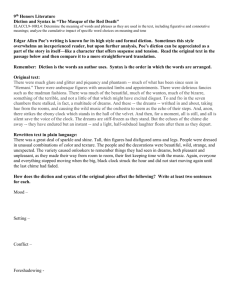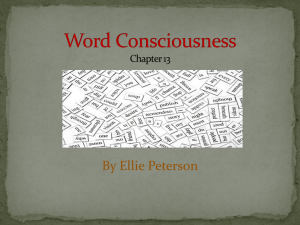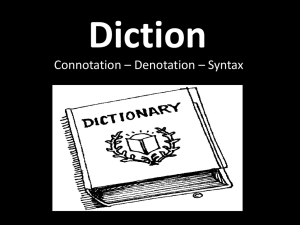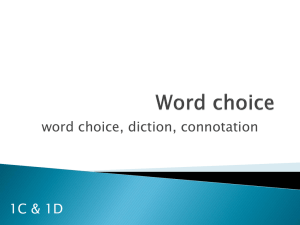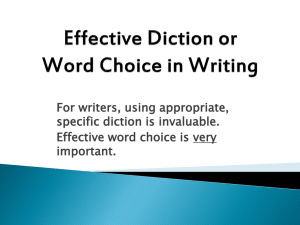DICTION In all forms of literature-nonfiction, fiction, poetry, and
advertisement
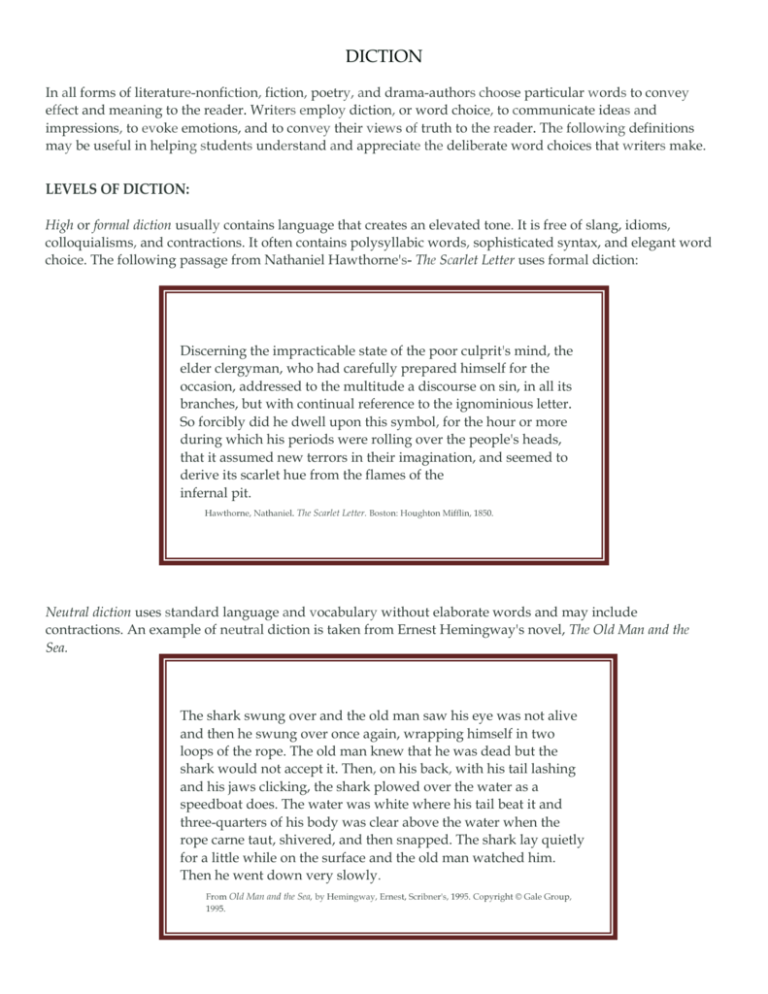
DICTION In all forms of literature-nonfiction, fiction, poetry, and drama-authors choose particular words to convey effect and meaning to the reader. Writers employ diction, or word choice, to communicate ideas and impressions, to evoke emotions, and to convey their views of truth to the reader. The following definitions may be useful in helping students understand and appreciate the deliberate word choices that writers make. LEVELS OF DICTION: High or formal diction usually contains language that creates an elevated tone. It is free of slang, idioms, colloquialisms, and contractions. It often contains polysyllabic words, sophisticated syntax, and elegant word choice. The following passage from Nathaniel Hawthorne's- The Scarlet Letter uses formal diction: Discerning the impracticable state of the poor culprit's mind, the elder clergyman, who had carefully prepared himself for the occasion, addressed to the multitude a discourse on sin, in all its branches, but with continual reference to the ignominious letter. So forcibly did he dwell upon this symbol, for the hour or more during which his periods were rolling over the people's heads, that it assumed new terrors in their imagination, and seemed to derive its scarlet hue from the flames of the infernal pit. Hawthorne, Nathaniel. The Scarlet Letter. Boston: Houghton Mifflin, 1850. Neutral diction uses standard language and vocabulary without elaborate words and may include contractions. An example of neutral diction is taken from Ernest Hemingway's novel, The Old Man and the Sea. The shark swung over and the old man saw his eye was not alive and then he swung over once again, wrapping himself in two loops of the rope. The old man knew that he was dead but the shark would not accept it. Then, on his back, with his tail lashing and his jaws clicking, the shark plowed over the water as a speedboat does. The water was white where his tail beat it and three-quarters of his body was clear above the water when the rope carne taut, shivered, and then snapped. The shark lay quietly for a little while on the surface and the old man watched him. Then he went down very slowly. From Old Man and the Sea, by Hemingway, Ernest, Scribner's, 1995. Copyright © Gale Group, 1995. Informal or low diction is the language of everyday use. It is relaxed and conversational. It often includes common and simple words, idioms, slang, jargon, dialect, and contractions. The following passage from The Bluest Eye by Toni Morrison uses informal diction: Three quarts of milk. That’s what was in the icebox yesterday. Three whole quarts. Now they ain’t none. Not a drop. I don’t mind folks coming in and getting what they want, but three quarts of milk! What the devil does anybody need with three quarts of milk? TYPES OF DICTION: Slang refers to a group of recently coined words often used in informal situations. Slang words often come and go quickly, passing in and out of usage within months or years. Colloquial expressions are nonstandard, often regional, ways of using language appropriate to informal or conversational speech and writing. The characteristic "ayah" of the Maine resident or the southern word "y'all" are examples of colloquialisms. Jargon consists of words and expressions characteristic of a particular trade, profession, or pursuit. Some examples of nautical jargon from The Secret Sharer by Joseph Conrad are "cuddy," "taffrail," "mizzen," and "binnacle." Dialect is a nonstandard subgroup of a language with its own vocabulary and grammatical features. Writers often use regional dialects or dialects that reveal a person's economic or social class. Mark Twain makes use of dialect in the following passage from The Adventures of Tom Sawyer: “Sho, there’s ticks a-pleny. I could have a thousand of ‘em if I wanted to.” “Well, why don’t you? Becuz you know mighty well you can’t. this is a pretty early tick, I reckon. It’s the first one I’ve seen this year.” Concrete diction consists of specific words that describe physical qualities or conditions. The following passage from The Bluest Eye by Toni Morrison uses concrete diction to describe an experience Pecola has at Junior's house: The tears came fast, and she held her face in her hands. When something soft and furry moved around her ankles, she jumped, and saw it was the cat. He wound himself in and about her legs. Momentarily distracted from her fear, she squatted down to touch him, her hands wet from the tears. The cat rubbed up against her knee. He was black all over, deep silky black, and his eyes, pointing down toward his nose, were bluish green…. Abstract diction refers to language that denotes ideas, emotions, conditions, or concepts that are intangible. Some examples of abstract diction from Joseph Conrad's Heart of Darkness are such words as impenetrable, incredible, inscrutable, inconceivable, and unfathomable. Denotation is the exact, literal definition of a word independent of any emotional association or secondary meaning. Connotation is the implicit rather than explicit meaning of a word and consists of suggestions, associations, and emotional overtones attached to a word. For example, the word house has a different emotional effect on the reader than does the word home, with its connotation of safety, coziness, and security. Good writers value both denotation and connotation, but while scientists may use more denotative words, literary artists tend to rely more heavily on connotative words for deepest meaning and strongest effect. Since connotative words have complex layers of associations and implications, writers spend a considerable/amount of time searching for just the "right words" to convey experience and truth. It is essential that students understand clearly the concepts of denotation and connotation and their role in making meaning of text. Misinterpreting denotation and connotation in a literary work translates into misinterpreting tone and theme. L.E.A.D One way to help you remember a method for analyzing how an author's word choices convey effect and meaning in a literary work is by using the acronym LEAD. Low or informal diction (dialect, slang, jargon) Elevated language or formal diction Abstract and concrete diction Denotation and connotation LOW OR INFORMAL DICTION: A first step could be to check for low or informal diction such as slang, dialect, and jargon. These expressions are often used in dialogue or directly by the speaker in stories told from the first person point of view. One strategy for deriving meaning from informal diction is to pay close attention to dialogue and to read the text aloud to hear how it sounds, attempting to determine meaning from sound and context. Another strategy is to refer to a thesaurus or dictionary that contains word histories and definitions of informal expressions. ELEVATED LANGUAGE OR FORMAL DICTION: A next step might be to check for elevated language, indicating the use of formal diction. Because formal diction includes more elaborate, polysyllabic words, it may be more difficult for students to understand. Teachers might ask students to pay close attention to complex words and to use a dictionary to help them define words they are unable to understand from the context. Students could paraphrase a difficult passage by rewriting it in their own words to determine the author's meaning. ABSTRACT AND CONCRETE DICTION: A next step in this process might be to examine the use of abstract and concrete diction. Writers may choose to use abstract or concrete words depending on the response they want to evoke from the reader. Although the more abstract words tend to be used impersonally to convey universal truths and emotions, writers in general tend to use specific, concrete words to describe people, places, and objects. Good writers also use active verbs to describe actions. Liberal use of abstract diction in a passage might make it more difficult to understand. Students can look carefully at a descriptive passage to find examples of effective descriptions of people, places, objects, and actions. DENOTATION AND CONNOTATION: Students could examine both the denotative and connotative meanings of unfamiliar words. Many English words have more than one denotative meaning, so the first strategy is to use context clues. Generally, the context (words and sentences surrounding a particular word) tells the reader which meaning is intended. If unable to discern the meaning of a word from its context, students could find the word in a dictionary.

